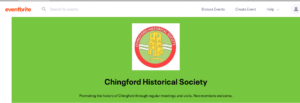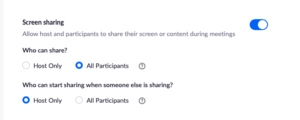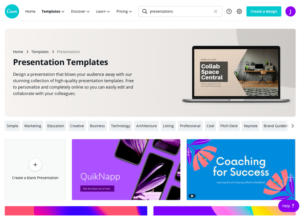Over the past few months it has been a bit of a steep learning curve for many of us in order to keep in touch with friends virtually and to try to get some sense of normal into our daily lives.
I have been on the committee of Chingford Historical Society since March last year having been lured onto the committee under false pretences – I’m not joking! As with many historical societies it’s run with a very small committee and it has been a struggle to attract new and younger members to ensure there are enough people to keep the society going well into the future.
With the help of our new chairman Gary Stone we have over the past year slowly brought the society into the 21st century. We started by purchasing some banners which are easy to transport and relatively cheap and make us as a society more attractive and welcoming. Here’s a photo of most of the committee at last year’s washed out May Day event. The bad weather meant we had a steady stream of people attending our stall. Actually I’ve just realised the new banners aren’t in shot at this event but the second image shows one of our banners – we have several – at a local history event at Walthamstow Pumphouse Museum.

May Day event 2019

Walthamstow Pumphouse local history event
However after attending a number of virtual guiding and London Historian meetings I wondered if we could do something similar with Chingford Historical Society.
I suggested having an online committee meeting via Zoom. The initial reaction was that this would be too technical and beyond some of the committee members’ capabilities. However I persevered and offered to do practice sessions simultaneously on Zoom and on the phone to talk them through the process. It was a success.
A date was then arranged for our first online members’ meeting in May which fortuitously coincided with our new website going live.
We proposed that as with our in real life meetings these would be open to non-members but there would be no charge.
I set up an Eventbrite account in Chingford Historical Society’s name using the colours from the website and our banners to ensure continuity and to give an up-to-date image. Having just previewed this post I now realise the colours are slightly different so a bit of editing is required!

The Eventbrite account was created so non-members could book in advance and we would have some idea of numbers although I did expect some no-shows as in real life free events!
As I wasn’t sure how familiar our members were with technology I decided to just circulate the bare Zoom link to existing members. Using the Mailchimp account I had created for the purpose I suggested that if any of them had any qualms about the process that they should contact me and I would do a test run with them.
We did have the issue that some of our membership don’t have email accounts but Gary set up a YouTube channel so meetings could be recorded and viewed afterwards and even created some DVDs for those members with no online access.

There were of course some who didn’t respond to our letter with details of the meeting but we weighed the pros and cons up and decided that the pros of having an online meeting rather than waiting for the point in the distant future when we could meet again outweighed the cons.
We have been overwhelmed with the success of our virtual meetings. We have received congratulatory emails and phone calls from members who were too frail to physically attend meetings or who had moved away from the area but were still interested in its history. Even when we’re back meeting physically we are planning to set up some means whereby the talks will be recorded and sent to those unable to attend in person.
We had fantastic feedback from non-members too. This resulted in a flurry of sign-ups to our Mailchimp newsletter to be kept informed of future talks. It had been agreed that no membership fees would be due until January to encourage people to join us. If you’d like to be kept informed you can do so here.
Tips for hosting your meeting via Zoom
Over the past few months I have accumulated a number of tips which I share below. This isn’t a beginner’s guide as there are plenty of those online but this list comes from my personal experience and includes tips which I hope others will find useful. All tips are in relation to using Zoom on a laptop; I’m afraid I have no experience of using a tablet or phone for the purpose. I have however heard that it is preferable to use a laptop or desktop computer if you are the host. I should also point out that I use the paid for version which costs £14.39 a month.
When scheduling a meeting it’s worth setting up some defaults in the Settings menu in advance of the meeting to save worrying about them when the meeting has started.
Mute Participants on Arrival
This is very important for a big meeting!
This is a check box within the Settings menu.

If you’re hosting a talk or similar you will want to keep the participants muted but if at some point people are going to be split into breakout groups they can then unmute themselves. If it is a talk you might want to unmute them so they can applaud! It is quite disconcerting giving a talk to receive no applause!
Co-hosts
It is really worth appointing one or more co-hosts so you as the host don’t have to worry about everything. Although the option to do this shows on the setting up page I have only done this when the meeting has started.
So as soon as the meeting is in progress go to the Participants tab at the bottom of the page (on a laptop), click the person you want to be co-host, click ‘More’ and one of the drop-down options is to make them co-host. You can have more than one co-host. It’s worth assigning your co-hosts their individual tasks in advance too – such as letting people in from the Waiting Room or muting people who have unmuted themselves and are being disruptive!

One reason to have a co-host is just in case you lose your internet connection. Back in May at Chingford Historical Society’s first ever virtual meeting, set up and hosted by me I lost my internet connection 3 minutes in!
But … the meeting carried on without me! I only realised it was still going on when a fellow committee member texted me saying that all was going well! Back in May I didn’t know about co-hosts or that if the host disappears hosting then jumps to a random person! (I found out all this afterwards.)
The host that had been randomly appointed was unaware they were the host (although a message telling them should have popped-up on their screen) so didn’t mute a noisy participant. My internet connection didn’t come back until well after the meeting had finished. I had set the meeting to record and even though I lost my internet the recording continued. The recording was automatically emailed to me after the meeting finished. Using his editing skills Gary was able to edit out some of the background noise and it’s barely audible. I was scared to watch it at first!
Co-hosts can eject people but please don’t do this if someone arrives early for the meeting as they won’t be able to get back in. This is what my co-host did at this month’s meeting. This option to eject someone is only meant for gatecrashers or people who are disrupting the meeting! So for this month’s meeting we didn’t have a waiting room enabled but we will do so in the future to avoid a similar situation – we were having a pre-meeting technical meeting!
Waiting Room*
In the past 2 months I have discovered that people that are new to Zoom sometimes click the live link hours or even days before the meeting time even if instructed not to do so! The host will then be sent a message saying their participants are waiting which can give you a bit of a shock – I once woke up to get this message from someone who had signed in 12 hours early!
So the best thing to do is to enable a Waiting Room in the Settings menu. As you can see you can customise it with your logo which I will be doing in time for our meeting in July.

With Waiting Room enabled anyone clicking early is told to wait for the host to start the meeting, but then, just before you officially start the meeting, turn the waiting room off. Anyone arriving after that will get straight in but you still have the means to eject any gatecrashers.
This option to turn the waiting room off can be found when you click on the Participants menu.
Also if a number of people are in the waiting room you can ‘Admit All’; you don’t need to admit them one at a time. Admitting All should really only be done if you are confident that the link hasn’t been shared on the web ie people have booked tickets in advance or you know the people you have sent the link to haven’t shared it.
*Update: 12 hours after I posted this Zoom sent out an update saying that as from 19th July all paid accounts will be required to have a passcode or a waiting room enabled. More details can be found here.
Questions
Before your talk commences ask the audience to type any questions into the chat box which is at the centre bottom of the screen on a laptop. Although the speaker does have access to the chat menu whilst screen sharing it does interrupt the flow and in my experience it is better to deal with questions after the presentation has finished. At a recent History in the Pub for London Historians other audience members answered some of the questions themselves!
Screen Sharing
Another thing I have noticed is that sometimes people share their screen by accident!
In the settings menu you have the option to either select that only the host can share or that participants can share. Zoom have clarified to me that ‘host’ in this case only means the main host and not co-host. If it will be a co-host doing the presentation you will need to set this option to Participants.

When sharing your screen it’s best to set it up in advance and to close unnecessary screens which you may not want to share with your audience! So before the meeting starts ensure you have your presentation already in the play setting so when you share the screen you are ready to go straightaway and don’t have to faff about finding the right screen and then pressing the slide show play button.
As you admit people into your meeting it is well worth having screen share on with a slide showing the title of the meeting which helps to make your meeting look professional.
Here’s an image showing the slide that was on screen as people joined our recent meeting. Yes, I know there is an apostrophe missing – I didn’t write it!

Sharing multiple presentations – say if a colleague’s laptop doesn’t have that functionality
If you have more than one presentation to show you will need to switch between them out of Zoom ie on a Mac I would press Cmd Tab to switch from Zoom to PowerPoint – close the presentation, get the other one on screen and then switch back. You can’t do it from the share screen view. I realised at our June meeting at a technical rehearsal which I had insisted we have before the meeting – it was well worth it!
Format for your slide show
Until earlier today I wouldn’t have typed this paragraph! However I have just watched an instructional video for Westminster Guides in which our acting-chair suggests using Canva instead of PowerPoint or Keynote. I already use Canva.com to produce professional looking flyers for my tour guiding business but had never realised that there was an option to create presentations. I will definitely look into this as I find it very easy to use. There are both free and paid for versions.
 Recording your meeting
Recording your meeting
As mentioned above this continues even if the host loses their internet connection! You can set this up either in the settings or once the meeting has started. This is probably a good job for a co-host as the speaker is likely to forget even with a big sign saying ‘Press Record’. I am guilty as charged! Thankfully my co-host realised I hadn’t pressed it and we only lost about 5 minutes which we re-recorded and then he joined them together. If you do this make sure you wear the same clothes!
Sharing your Zoom link
Don’t put the Zoom link out on social media! I went to a meeting recently that was zoom bombed by someone showing porn! The host managed to end the meeting but then a new link had to be emailed round and about 10 minutes was lost.
Eventbrite
In the past few weeks Eventbrite have brought out a new event template specifically for online meetings. This embeds the Zoom link into the event so there is no need to send round the link separately. The only thing is that you may have to explain this in the blurb about your tour as I have had emails from a few people saying they weren’t able to figure out how to access it. One of the issues is that the participant needs to be logged into their Eventbrite account for the link to appear,
Your physical setting
Put a couple of books under your laptop for a more flattering view. Obviously curate the view behind you – no mess!
Background noise
This is another tip hot off the press from watching Westminster Guides’ video this morning. There is an app called Krisp which you can download for free. This will cut out any background noise both at your end – such as your phone ringing – and at the other end with anyone else who might be speaking.

If you don’t want to use an app such as this I would suggest putting your phone on silent and unplugging your landline if you have one. I also closed any windows.
I have only used Zoom for these meetings and have been quite happy with the ease of use and options available when setting the meeting up. So I was quite surprised to see that it didn’t score very well in Which Magazine’s tests in this month’s magazine. Their Best Buy for video calling apps was Skype. However I have now invested so much time in getting the best out of Zoom I will stay with it. You might need to pay to view it but the article is here https://www.which.co.uk/news/2020/06/zoom-review-improved-security-but-fails-in-which-call-quality-tests/
Lastly if anyone would like to see Chingford Historical Society’s latest online meeting you can watch it here. I come on about 2 minutes 15 seconds in and talk about a forgotten sporting hero.
I’d be grateful to know in the comments below if this is of any use and of course if you have any tips of your own to share. Lastly, I’d be really interested to know what other local history societies have gone online. I would love to attend a local history society in the Dundee area for instance to find out more about the place where my ancestors came from.
The author of this blog (Joanna Moncrieff) is a qualified City of Westminster and Clerkenwell & Islington Tour Guide and when not in lockdown leads regular walks both in Central London and Chingford and Walthamstow. Joanna is also available for online talks.
Thanks, Joanna, for this blog. I belong to the Sandbach History Society in Cheshire and we are having our first online meeting next week on Zoom and I am hosting it. It has been very helpful reading your hints and comments and I also watched the meeting on You Tube. I notice that you controlled the PowerPoint presentation for David (moved the slides on); was this because David asked you to do this (I think he was on a mobile device) or is this general practice?
I am pleased it was useful for you. Did you spot that there’s another blog post on the same subject with some more tips? I will put a link here. It is normal practice for the speaker to move their own slides on but although I can’t remember that occasion it must have been because he was on a mobile. Of course if the speaker wanted someone else to move their slides on the slides would have to be sent in advance to the other person in advance of the meeting – via We Transfer or similar. We at Chingford Historical Society have now moved onto hybrid meetings! At our November meeting 44 people attended in real life in a hall and 30 joined via Zoom. Amazingly it went more or less smoothly. If you need any more info please email me – Joanna [at] westminsterwalks [dot] London and I hope all goes well next week. https://westminsterwalks.london/how-to-move-your-historical-society-into-the-21st-century-part-2/